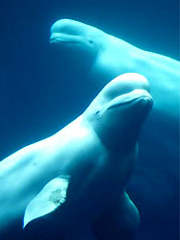|
BELUGA } Delphinapterus leucas

|
RANGE: Belugas have a circumpolar distribution, with about 30 separate populations occurring throughout the Arctic region.
STATUS: Belugas as a species are considered Near-threatened by the International Union for Conservation of Nature (IUCN), while Alaska’s Cook Inlet subpopulation is classified as Critically Endangered by the IUCN and is listed as Endangered under the U.S. Endangered Species Act.
THREATS: Industrial development, pollution, sewage discharge, oil and gas development, gillnets, ship traffic, sonar devices, global warming, and underwater seismic blasting.
The beluga whale inhabits the icy waters of the Arctic and sub-Arctic. With white skin to blend in with its surroundings, a thick layer of blubber to keep warm, and a smooth back to help slide beneath floating ice, this marine mammal is perfectly adapted to its chilly environment. Family groups of belugas travel together and communicate with squeaks, clicks, whistles, and clangs—some of the sounds these very vocal “sea canaries” make can even be heard above water. The beluga has only a few natural predators—orcas are a constant danger, while in winter polar bears use their claws to drag belugas from the water when they become trapped by ice—but human activities and pollution pose an enormous threat to this species. Through the Center for Biological Diversity’s advocacy, the Cook Inlet beluga whale finally gained desperately needed protection as an Endangered species this year.
LEARN MORE ABOUT THE COOK INLET BELUGA WHALE
|